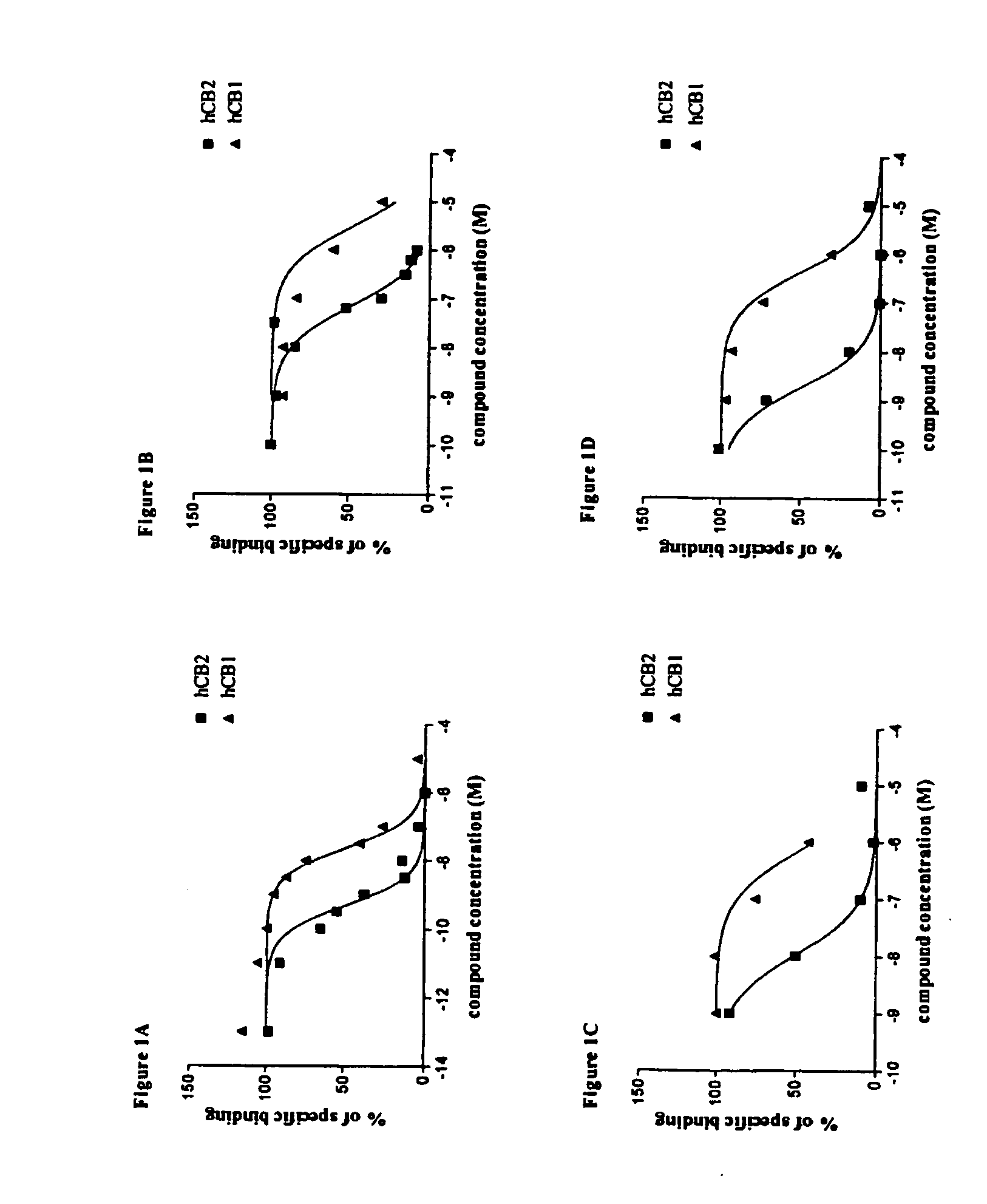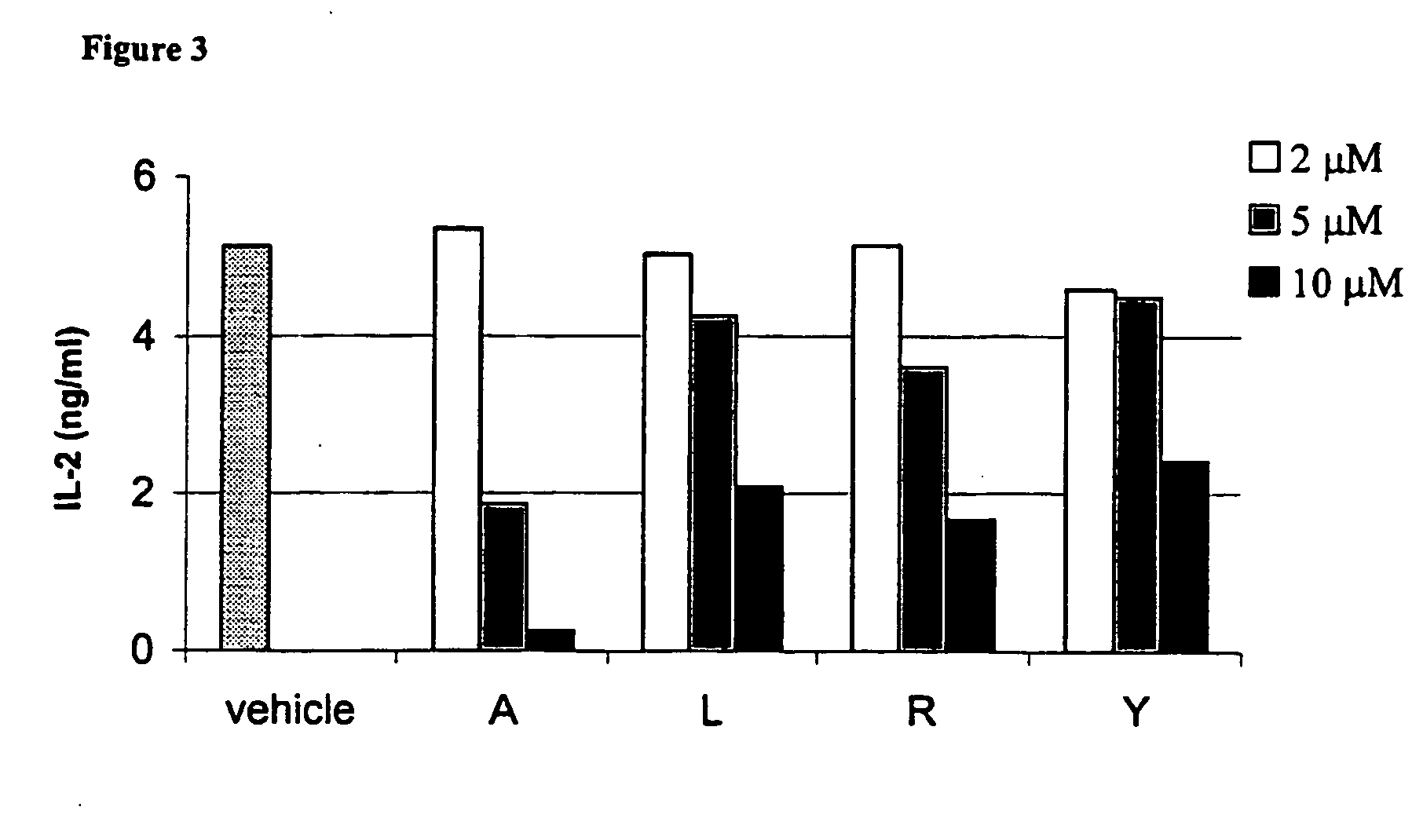Bicyclic CB2 cannabinoid receptor ligands
a cannabinoid receptor and bicyclic cb2 technology, applied in the field of+ pinene derivatives, can solve the problems of immunomodulation, no therapeutic activity, and only recently achieved immunomodulation, and achieve the effect of effective treatment and prevention
- Summary
- Abstract
- Description
- Claims
- Application Information
AI Technical Summary
Problems solved by technology
Method used
Image
Examples
example 1
Binding Affinity for the CB1 and CB2 Receptors
The CB1 binding assays were performed by testing the ability of the new compounds to displace [3H]CP55940 from the CB1 receptor on membranes derived from hCB1 stably transfected HEK-293 cells (Perkin Elmer / NEN). Membranes were diluted in the assay buffer (50 mM Tris-HCl, 2.5 mM EDTA, 5 mM MgCl2, 1 mg / ml BSA, pH=7.4) to 500 μg protein / ml. 50 μl of diluted membranes (25 μg) were incubated with [3H]CP55940 in the presence or absence of the bicyclic test compounds in a total volume of 0.5 ml. Tested compounds were dissolved in DMSO and diluted in the assay buffer to a final concentration of 0.1% solvent. Control samples were added with identical amount of vehicle. Non-specific binding was measured by the addition of 10 μM of WIN 55212-2. Following 1.5 hours incubation at 30° C. reactions were filtered through Whatman 934A / H filters (presoaked with 0.1% Polyethylenimine (PEI)).
The affinities of the novel bicyclic analogs to the CB2 recept...
example 2
Anti-Inflammatory Properties of the Bicyclic CB2 Ligands in Vitro
Specific aspects of the inflammatory response cascade are mediated by cytokines, such as TNF-α, IFN-γ, IL-2 and IL-1β and by inflammatory mediator such as COX-2 and PGE2. Modulating the levels of these pro-inflammatory agents is very important for the severity of the final inflammatory outcome. These agents are also produced by activated cells of the immune system, and the purpose of this study is to test the impact of the new bicyclic CB2 ligands on secretion of these inflammatory agents from activated macrophages and T cells. The levels of secretion in the various test groups are measured by ELISA assays and the level of inhibition is calculated versus the vehicle treated group.
Quantitation of Protein Using ELISA.
The technique used to quantify the amount of a given protein in a liquid sample, either tissue culture supernatant or body fluid, is based on Enzyme Linked ImmunoSorbent Assay (ELISA) methodology. Eith...
example 3
Effect of Compounds on Gene Expression
The inhibitory activity displayed by some bicyclic CB2 binding compounds on the secretion of inflammatory agents in activated cells of the immune system, either in vitro or in vivo, may be related to regulation of gene expression.
RNA Preparation and Real-Time RT-PCR.
Total RNA is prepared using SV total RNA isolation system (Promega). The cells or tissues are homogenized in lysis buffer. The lysates are transferred to an RNA isolation column, treated with DNAse, washed and eluted according to kit instructions. RNA concentrations were determined using GeneQuant II (Pharmacia-Amersham). Complementary DNA (cDNA) is synthesized from total RNA using SUPERSCRIPT II reverse transcriptase (Life Technologies). 2 μg of total RNA are combined with an oligo (dT)15 primer, 0.5 mM dNTP mix, 8 units of reverse transcriptase and other reaction components up to a final volume of 20 μl, according to the kit instructions. The reaction mixture is incubated at ...
PUM
| Property | Measurement | Unit |
|---|---|---|
| pharmaceutical composition | aaaaa | aaaaa |
| concentrations | aaaaa | aaaaa |
| affinity | aaaaa | aaaaa |
Abstract
Description
Claims
Application Information
 Login to View More
Login to View More - R&D
- Intellectual Property
- Life Sciences
- Materials
- Tech Scout
- Unparalleled Data Quality
- Higher Quality Content
- 60% Fewer Hallucinations
Browse by: Latest US Patents, China's latest patents, Technical Efficacy Thesaurus, Application Domain, Technology Topic, Popular Technical Reports.
© 2025 PatSnap. All rights reserved.Legal|Privacy policy|Modern Slavery Act Transparency Statement|Sitemap|About US| Contact US: help@patsnap.com



